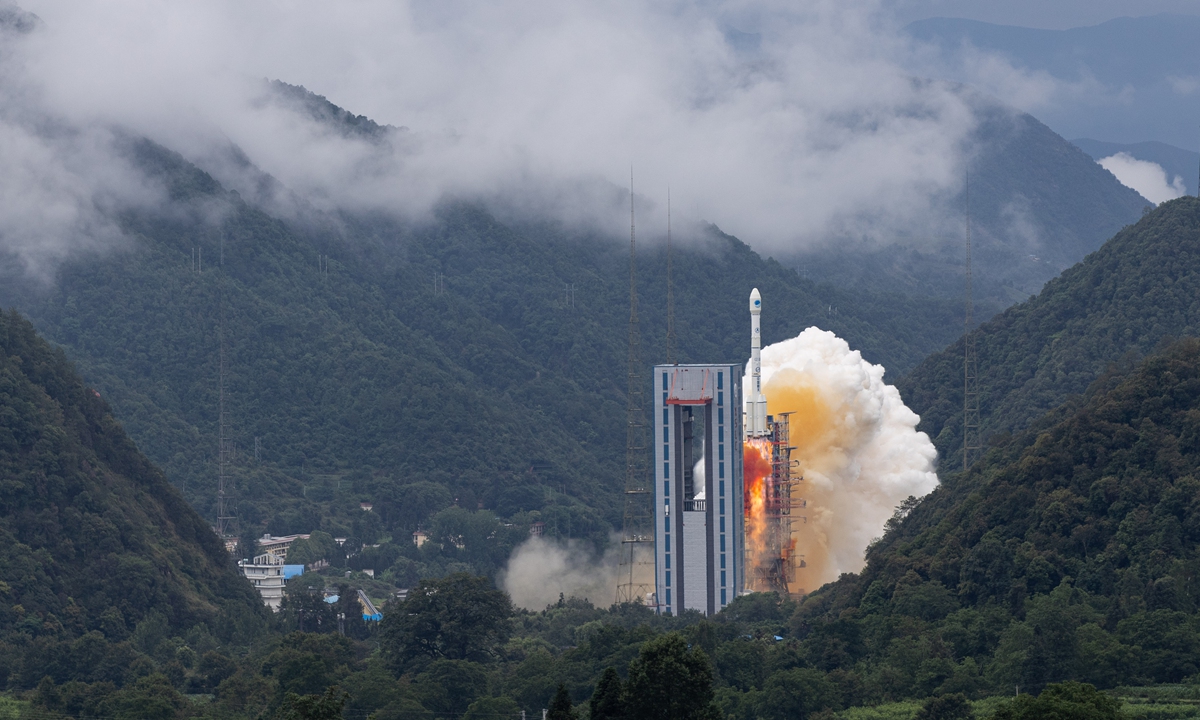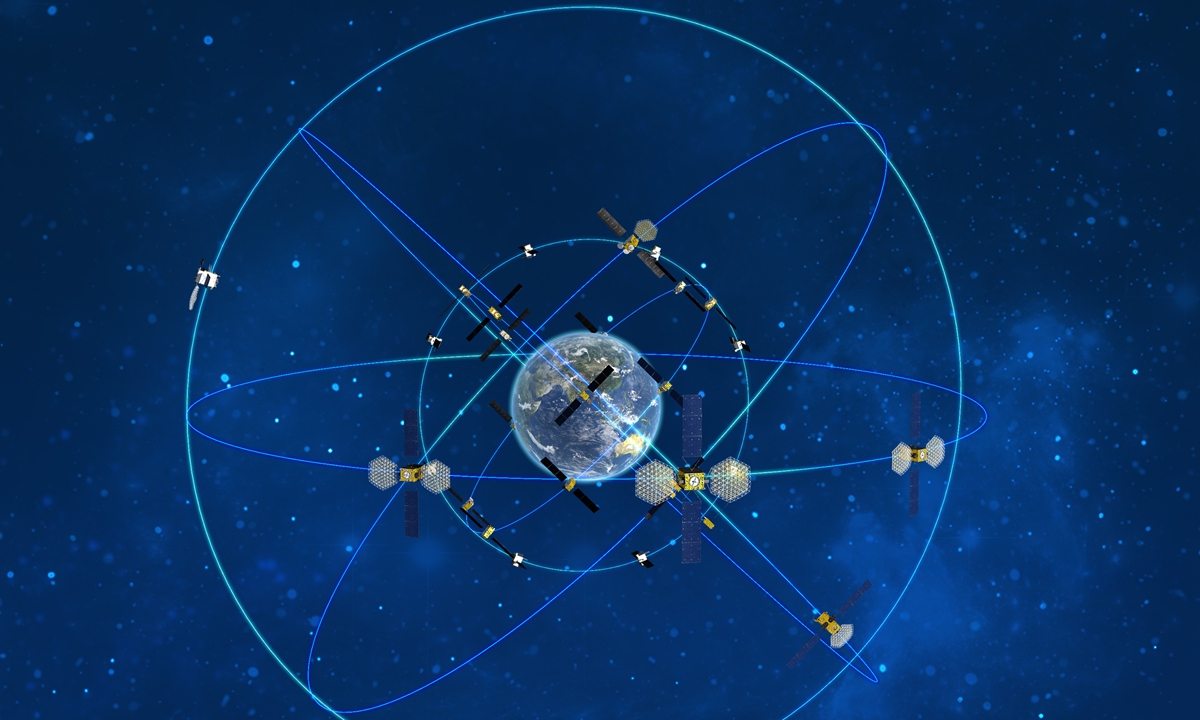Breathtaking rescue fixes satellite glitch and ensures 100% success rate of China's BDS deployment
Star shepherds

Staffers at the Xi'an Satellite Control Center work to rescue the BDS-3 GEO-2 satellite in March 2020. Photo: Courtesy of Xi'an Satellite Control Center
"It was like a man standing upright when he was suddenly pushed to the left by an external force, and then to the right," Wang Xin, a senior engineer with the Xi'an Satellite Control Center described, as he recalled the satellite emergency in March 2020 where the second last satellite of the third generation of BeiDou Navigation Satellite System or the BDS-3 encountered an abnormal change of attitude and faced the real possibility of veering out of control.
Starting from 1994, China has sent a total of 59 BeiDou satellites into orbit in 44 space launch missions with a 100 percent success rate, and on July 31, 2020, the country announced the completion and official commissioning of the domestically developed mega space infrastructure project.
Apart from the strong performance of launch vehicles and satellites, there is a mysterious team of "star shepherd" behind the remarkable success, who are guarding China's largest satellite constellation to date around the clock.
Overcoming adversity including the COVID-19 epidemic, it was this very team that pulled off a space rescue when the BDS-3 GEO-2 satellite experienced abnormalities in March 2020 and managed to return the satellite back to its preset orbit.
A terrifying moment
China launched the BDS-3 GEO-2 satellite into a preset orbit some 200 kilometers above the ground via a Long March-3B carrier rocket from the Xichang Satellite Launch Center on March 9, 2020. As the satellite's solar panel unfolded, the launch mission marked a success.
It was the 29th member of the BDS-3 system, meaning there was but one satellite [GEO-3 to be launched in June] to go before the completion of complete deployment of all BDS-3 satellites.
By plan, the GEO-2 satellite was originally expected to carry out five orbit transfers to its final destination of geostationary orbit of 36,000 kilometers.
However, after a smooth first maneuver, an accident occurred. Remote sensing data indicated that the attitude of the satellite was reporting an abnormal change after the main satellite engine ran for more than 10 minutes.
"There was a interfering force, causing disturbance to the satellite's attitude," Wang told the Global Times.
Such an anomaly would usually lead to disastrous consequences, which according to Wang, included the damage of onboard equipment. Even worse, it could also result in a total severing of communication between the satellite and ground command, and the supporting team on the ground would not be able to monitor and control the satellite in question.
The flight control team, faced with the emergency situation, had to quickly formulate a response to rein in the satellite's attitude before it was too late.
Adding to the difficulties, due to then epidemic situation, the ground control team could not meet face to face with the satellite development team although the latter was also in Xi'an.
The ground monitoring and control team first worked out a critical value for the abnormal parameters, and when the situation hit the value, they would have to shut down the main engine to secure the satellite.
"If the parameter surpasses the critical point, the satellite would probably lose communication and control. If we did not order a shut down for the main engine, the satellite would not be able to do so once over the edge. And if that happens, we would have no knowledge over what the satellite's situation would be and where it would go," Wang explained.
Preliminary study by the team found that it was the issues with the main engine that caused the abnormal change of attitude, since it was the only propellant unit that was working. Once the main engine was shut down, the satellite would be able to hold steady.
Eventually, after five minutes into the anomaly, the parameter hit the critical value the scientists set and they made the call to shut down the main engine. And that worked to bring the situation under control.
That is to say, within only five minutes into the anomaly, we worked out the location of problem, formulated an emergency response and ran tests, and that saved the satellite from falling totally out of control, Wang recalled. "It was truly breathtaking in every step."
Following this incident, China launched the last BDS satellite in June 2020, marking the completion of the deployment of its own global navigation system.
The satellite, the 55th in the family of BeiDou which means "Big Dipper" in Chinese, was launched and sent into its preset orbit by a Long March-3B carrier rocket from the Xichang Satellite Launch Center.

Carrying the last BDS-3 satellite, a Long March-3B carrier rocket takes off from the Xichang Satellite Launch Center on June 23, 2020. Photo: VCG
The BDS system provides navigation signals across multiple frequencies, and is able to improve service accuracy by using combined multi-frequency signals.
It also integrates navigation and communication capabilities for the first time, and can provide services of navigation, short message communication, satellite-based augmentation, international search and rescue, as well as precise point positioning.
The value of China's self-developed BDS exceeded 400 billion yuan ($62.8 billion) by the end of the 13th Five-Year Plan (2016-20) period, the country's top economic planner the National Development and Reform Commission (NDRC) said in April this year.
As of the end of 2021, there have been more than 1 billion terminal devices connected to the BDS positioning service and a total of 324 million domestically made smartphones sold in 2021 applicable to the system, accounting for 94.5 percent of the total shipment of domestic smartphones.
BDS is China's largest space-based system and one of four global navigation networks alongside the US' GPS, Russia's GLONASS and the European Union's Galileo. BDS can provide diverse services and powerful functions. Globally, it can provide services enabling positioning, navigation and timing, global message communication, and international search and rescue. In the Asia-Pacific region, its services include regional short message communication, precise point positioning, and satellite-based and ground-based augmentation.
Making things right in 20 days
Rescuing the satellite from going out of control was only the start. As the most versatile, largest type of satellite with longest service life, the BDS-3 GEO satellite was too expensive to give up.
Starting from November 11, 2017, China scheduled a tight 18 launches for 30 BDS-3 satellites in a period just slightly over two years.

Illustration of BDS-3 system
Besides, "it would take another year to launch a back-up GEO-2 satellite, and that would delay the goals of deploying all BDS-3 satellites within 2020," Wang said.
The Xi'an ground monitoring and control team, after resolving the crisis, conducted a detailed analysis with the satellite development team. They located and identified the malfunction as being burn-through at the effuse at the main engine.
The team faced two options to recover the satellite that was in the some 6,000 kilometers transfer orbit to the destination GEO. One was to try to restart the main engine following the previous plan and the other was more complex yet less risky - using smaller propellant units that were tasked for attitude control to reach its goal.
The second plan was also very challenging, as it would require real-time communication during orbit changes and involve high-precision switch on/off directions for the thrusters from the ground. The ground team must try to save as much fuel in the satellite's tank as possible so that the new orbital transfer plan would not affect the service life of the thrusters of the satellite.
They decided to go with the second plan, which was more complicated but safer.
On March 28, 2020, 20 days after the launch, the GEO-2 satellite managed to climb onto the 36,000 kilometers GEO in some 20 orbital transfers of high precision with the help of its thrusters, declaring the redemption of the satellite.
In even better news, monitoring data showed that the maneuver did not affect the service life of the satellite thanks to the high-precision control from the ground team.
A glorious decade
Space assets are national strategic assets, Chinese President Xi Jinping stressed in September 2021, urging officers to comprehensively strengthen protection capabilities, disaster recovery and backup, invulnerability and survivability, and information protection capabilities.
As the number of satellites in orbit increases, and their service capabilities grow more powerful in the past decade, the Xi'an Satellite Control Center "Star Shepherd" team shoulders an increasingly important responsibility.
Yang Yong'an, a senior Engineer with the Xi'an center, told the Global Times that more than 300 satellites are now under long-term management of the center, and one third of them are working beyond their designed life.
Due to the team's outstanding operation and maintenance, those satellites are still working well despite a growing number of aging units, Yang said.
Over the past decade, the center has formed full-range capabilities from fault diagnosis to repairing. It has carried out a number of space rescue missions for satellites including Zhongxing-9A and BDS-3 GEO-2, achieving many space miracles.



